
The benchmark for the old towns in the cities we’ve visited is either Prague or Krakow, which are not reconstructed medieval cities, but survived the World Wars (and their many predecessors in Europe) intact.
If we could have chosen any day to spend on a bus, yesterday might have been a candidate for the eight-hour ride from Warsaw to Krakow. It has been cool, with periods of rain, but yesterday was prime hypothermia weather–40s and steady rain. You might say it put a damper on our two  visits–to the Queen of Poland church in Chestowa and a 14th century castle. The castle ruins, set high on a hill, weathered much worse weather–but only 9 of us weathered the weather to get up to it–Zamku Ogrodzieniec–and fewer still could pronounce it. As I pointed out though, it’s every boy’s dream (mine anyway) to wander through a castle and pretend. As for the Queen of Poland, the Pauline church/monastery was about the only thing that the Swedes did not capture in 1655; that made the Madonna sacred to this day. When Father Roman took us through the chapel, a mass was occurring, but there was a cordon that let us go around the altar during the service.
visits–to the Queen of Poland church in Chestowa and a 14th century castle. The castle ruins, set high on a hill, weathered much worse weather–but only 9 of us weathered the weather to get up to it–Zamku Ogrodzieniec–and fewer still could pronounce it. As I pointed out though, it’s every boy’s dream (mine anyway) to wander through a castle and pretend. As for the Queen of Poland, the Pauline church/monastery was about the only thing that the Swedes did not capture in 1655; that made the Madonna sacred to this day. When Father Roman took us through the chapel, a mass was occurring, but there was a cordon that let us go around the altar during the service.
At least the weather cooperated for our last night in Warsaw, where, after a birthday cake dinner for our four trip celebrants, about half of us took advantage of the “night of the museum.” Most of the museums in town were open, and old-time buses came out of retirement to provide free rides; nearly the whole population of Warsaw took advantage of the festivities, which went on until 3. I lasted till about 1:30, when we went to a prison museum. Built originally by the Russians to house political prisoners after an uprising in 1830, the prison was used by subsequent rulers until it was destroyed in the general destruction of Warsaw in 1944. Then we went to the Museum of Independence, where I spent some time learning about the aftermath of the First World War, and the recreation of the Polish state’s boundaries. I’d learned about Versailles, knew about some of the plebiscites (votes to determine where a city’s allegiance lay), but didn’t realize that the “Council of Ambassadors” and a series of short wars were ultimately responsible for defining Poland’s borders with its neighbors.
As might be expected, in 1945, there were further adjustments, as Russia moved Poland into Germany! Those who went did so partly because we wanted to attend the concert staged by faculty from the University, Chopin Piano Concerto #1. We weren’t sure where it was being staged, so we stood in line for about 20 minutes before we realized that we were in the wrong line–the queue was for apartments not usually open at the Royal Palace. We rushed to Maryskaya (?), a palace for the wife of Jon III Sobieski, where we were treated to a wonderful rendition of the concerto. I’m not a big fan of Chopin in general, but I certainly was that night. Incidentally, one of the innovative features of the Chopin museum that I wrote about yesterday was that it used RFID cards, which dictated that I would get English-language, moderately informative displays. Cutting edge of museology.
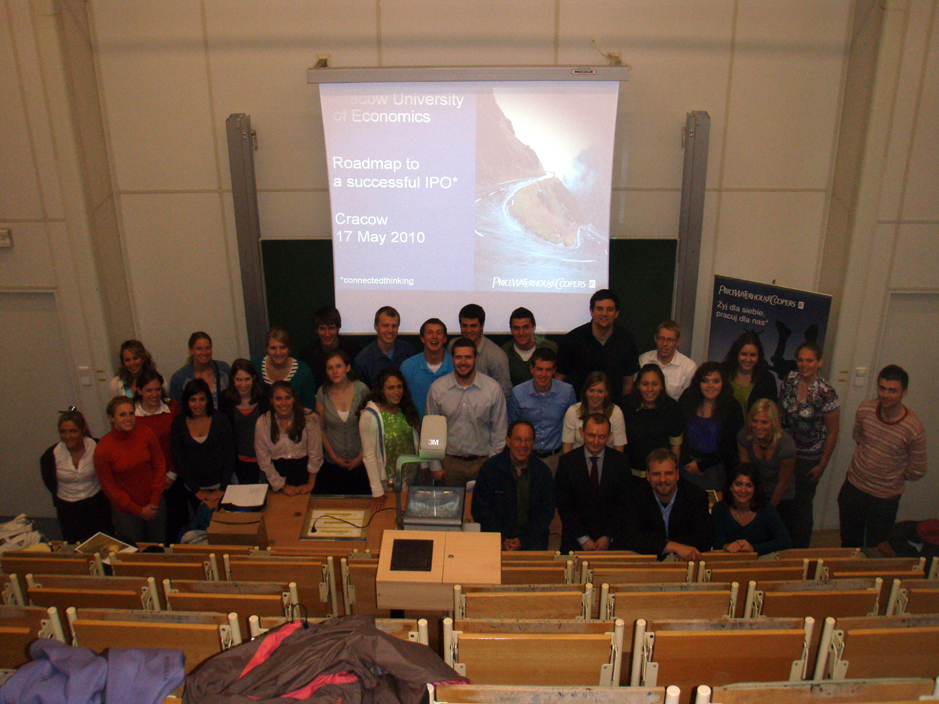
Back to Cracow (or Krakow). We spent a cool, wet day doing some really cool semi-dry things. Part of that was a business visit to the University of Krakow, which was the setting for a lecture on Polish initial public offerings (IPOs). In what everyone hopes is a recovering market, Poland is privatizing some of its former state-owned enterprises to raise revenues. It is offering some of the largest IPOs currently in Europe, partly a function of a separate stock exchange (i.e., not SEC or its European equivalent) that handles riskier transactions. The presenter was from PriceWaterhouseCooper, who I contacted through Jim Majernik, a PWC employee who works in Amsterdam; Jim came with me in May 2001 when we went around the world. PWC is one of the partners who provide advice to companies that seek IPOs. Each PWC country is in effect a franchised partnership, which I had not really known.
The afternoon was devoted to identifying and visiting the major sites of Krakow. The city of 800,000 is historically important in Polish history, and a tourist mecca because it was leveled by the Mongol armies (there’s my connection with Asia!), rebuilt, and, unlike most Central and Eastern European cities, has never again been destroyed. As I said earlier, it’s the old town most of the other cities have rebuilt–but it’s original. Its historical significance to Poland comes from the fact that before Poland united with the Grand Duchy of Lithuania in the late 16th century, it was the capital of the Polish state. During the golden age of Poland (13th and 14th centuries) it was one of the most important cities in Europe. Much of the history is left.
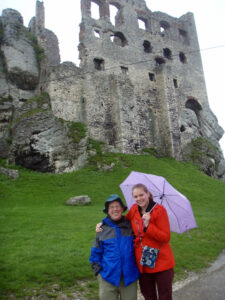
We visited the castle, built and rebuilt (and rebuilt to look like its 1760s equivalent), with a wondrous Renaissance courtyard. Built on a hill, the castle has an attendant church that houses not just the kings of Poland, but many of its heroes as well: President Kuczynski is being interred there, as well as Thaddeus Kosciuszko, who helped America win its Revolution and was granted American citizenship; he came back to Poland to help keep Poland independent–in vain. Kings came to the castle, Wawel, to be married, crowned, or buried. The infamous German governor during WWII, Hans Frank, also lived in the castle, as did the Austrian guards while Krakow was under Austrian rule (1790s-1918). Today it is part of the historical museums.
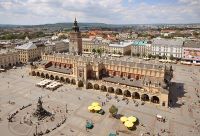 We also visited the old town square, which is dominated by the Cloth Hall, a merchant building a block long that was most recently altered in the 18th century, but was under reconstruction today. Too bad. I remember it from 9 years ago as strikingly different from the other town halls I have seen. Also on the square is St.Mary’s Church, which is interesting on the outside because its
We also visited the old town square, which is dominated by the Cloth Hall, a merchant building a block long that was most recently altered in the 18th century, but was under reconstruction today. Too bad. I remember it from 9 years ago as strikingly different from the other town halls I have seen. Also on the square is St.Mary’s Church, which is interesting on the outside because its  twin towers are different (the town ran out of money), but the inside is truly spectacular. It has a wooden altar that is one of the largest in the world; it’s late Gothic, made by a German woodworker, who took 12 years to complete it.
twin towers are different (the town ran out of money), but the inside is truly spectacular. It has a wooden altar that is one of the largest in the world; it’s late Gothic, made by a German woodworker, who took 12 years to complete it.
The other highlight of Krakow is poignant–the old Jewish sector. Casimir 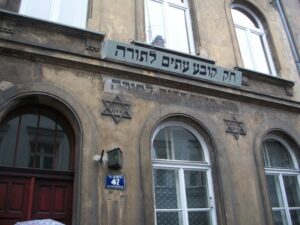 the Great invited Jews to settle in Krakow in the 15th century, and they came, mostly from Germany (Regensburg was one of the towns mentioned; it was where the Parliament of the Holy Roman Empire met, a city I visited last summer. I was struck by the interconnectedness of medieval trade). At one time (before WWII), Jews comprised about a quarter of the population
the Great invited Jews to settle in Krakow in the 15th century, and they came, mostly from Germany (Regensburg was one of the towns mentioned; it was where the Parliament of the Holy Roman Empire met, a city I visited last summer. I was struck by the interconnectedness of medieval trade). At one time (before WWII), Jews comprised about a quarter of the population 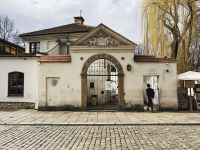 of the city. Today, however, fewer than a thousand remain. What struck me, however, was how much more of the area was rebuilt than when I was here in 2002. There’re museums, delicatessens, restaurants, plaques–historical memories and a chic part of the city.
of the city. Today, however, fewer than a thousand remain. What struck me, however, was how much more of the area was rebuilt than when I was here in 2002. There’re museums, delicatessens, restaurants, plaques–historical memories and a chic part of the city.
Some of us this evening attended a concert in the baroque Sts. Peter and Paul church, which featured baroque music. Especially neat was the version of Vivaldi’s Four Seasons. It feels like fall outside! The flooding, however, endangers our plans to visit the extermination camp of Auschwitz. We’ll know at 8 a.m.
We’re leaving Krakow Tuesday, having realized it’s all it’s cracked up to be.